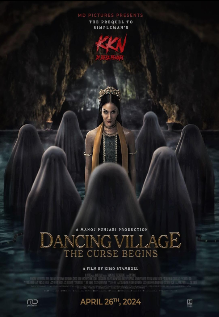Review: ‘Dancing Village: The Curse Begins’ serves as a prequel to ‘KKN di Desa Penari,’ Indonesia’s highest-grossing film. While the original film was highly entertaining, this prequel falls flat. Although it excels in building tension and creating a strong atmospheric horror in the first half, the second half disappoints as the suspense fades and the chills are lost. Given director Kimo Stamboel’s reputation, this is a significant letdown. The film offers a minimal storyline, resulting in a stretched narrative that significantly impacts its pacing and overall engagement.
The film opens with a flashback to 1955, depicting a remote Indonesian village where a room full of dancing women in traditional sarongs is on the brink of collapse. We then meet Mila (Maudy Effrosina), a young girl on a mission to return her mother’s bracelet to break a long-standing curse. Accompanied by her cousin Yuda (Jourdy Pranata) and two friends, Mila travels to the village and finds refuge at Ratih’s (Claresta Taufan Kusumarina) house. There, she encounters strange occurrences tied to her mother and discovers that Ratih’s mother suffers from the same mysterious ailment. As Mila starts seeing visions of Badarawuhi (Aulia Sarah), an evil witch who incorporates dancing into her dark rituals, the situation takes a sinister turn.
The film’s ominous cinematography and haunting music score effectively create a chilling atmosphere, immersing viewers in a mysterious village where every resident has an enigmatic presence. The dense forest shots, dancing rituals, and Mila’s bath scene contribute to the eerie ambiance, though the overall plot and performances undermine what could have been a captivating story. While the film doesn’t feature many jump scares, the ones it does have make an impact. Watch for the scene where Mila is bathing in a desolate community pool and is suddenly encircled by slithering snakes; it’s guaranteed to send shivers down viewers’ spines.
The film lacks any standout performances, and while Kimo Stamboel successfully crafts a haunting atmosphere, his direction doesn’t go beyond that achievement. Hailing from Indonesia, this horror film offers a fresh perspective in the genre, especially following the success of Korean and Japanese horror. It brings a unique flavour and introduces audiences to Indonesian horror, though it falls short in key areas like performances. Despite the recent surge of impressive horror films from Indonesia, it’s unfortunate that Indian viewers will see this one first.
